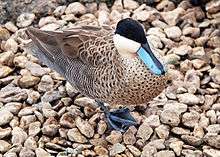Puna teal
| Puna teal | |
|---|---|
_RWD.jpg) | |
| A puna teal at Sylvan Heights Waterfowl Park in Scotland Neck, North Carolina. | |
| Scientific classification | |
| Kingdom: | Animalia |
| Phylum: | Chordata |
| Class: | Aves |
| Order: | Anseriformes |
| Family: | Anatidae |
| Subfamily: | Anatinae |
| Genus: | Anas |
| Species: | A. puna |
| Binomial name | |
| Anas puna Tschudi, 1844 | |
| Synonyms | |
|
Anas versicolor puna | |
The Puna teal (Anas puna) is a species of dabbling duck in the genus Anas. It was previously regarded as a subspecies of the silver teal.
The Puna teal is resident in the Andes of Peru, western Bolivia, northern Chile, and extreme northwestern Argentina.[1][2] It is found on the larger lakes and pools in the altiplano. They are sometimes kept in mixed collections but are protective of females and eggs during the breeding season.
The status of the Puna teal is Least Concern, as listed on the IUCN Red List.[1]
Description

The Puna teal is 19 inches (480 mm) long, similar in size to a wood duck. They have a black cap that extends to below the eyes. Their lower face and neck are creamy white. Their upper tail coverts are gray, and their rear flanks are dark brown with thin stripes. Back, chest and lower flanks are light coffee with dark brown spots. Their bill is large, light blue with a black line down the middle
Behaviour
In the wild they live in small groups of their own kind or with the closely related silver teal. Puna teal lay their eggs between April and June. Like swans and geese both parents rear the ducklings. They lay their eggs in long grass, not always close to the water. The eggs are a creamy pink colour of which there may be several. The relationship between the male and female may be long term.[3]
Footnotes
- 1 2 3 BirdLife International (2012). "Anas puna". IUCN Red List of Threatened Species. Version 2013.2. International Union for Conservation of Nature. Retrieved 26 November 2013.
- ↑ Clements, J. (2007)
- ↑ "Puna teal". Aves de Chile. Archived from the original on 11 January 2009.
References
- Clements, James (2007). The Clements Checklist of the Birds of the World. Ithaca: Cornell University Press.
